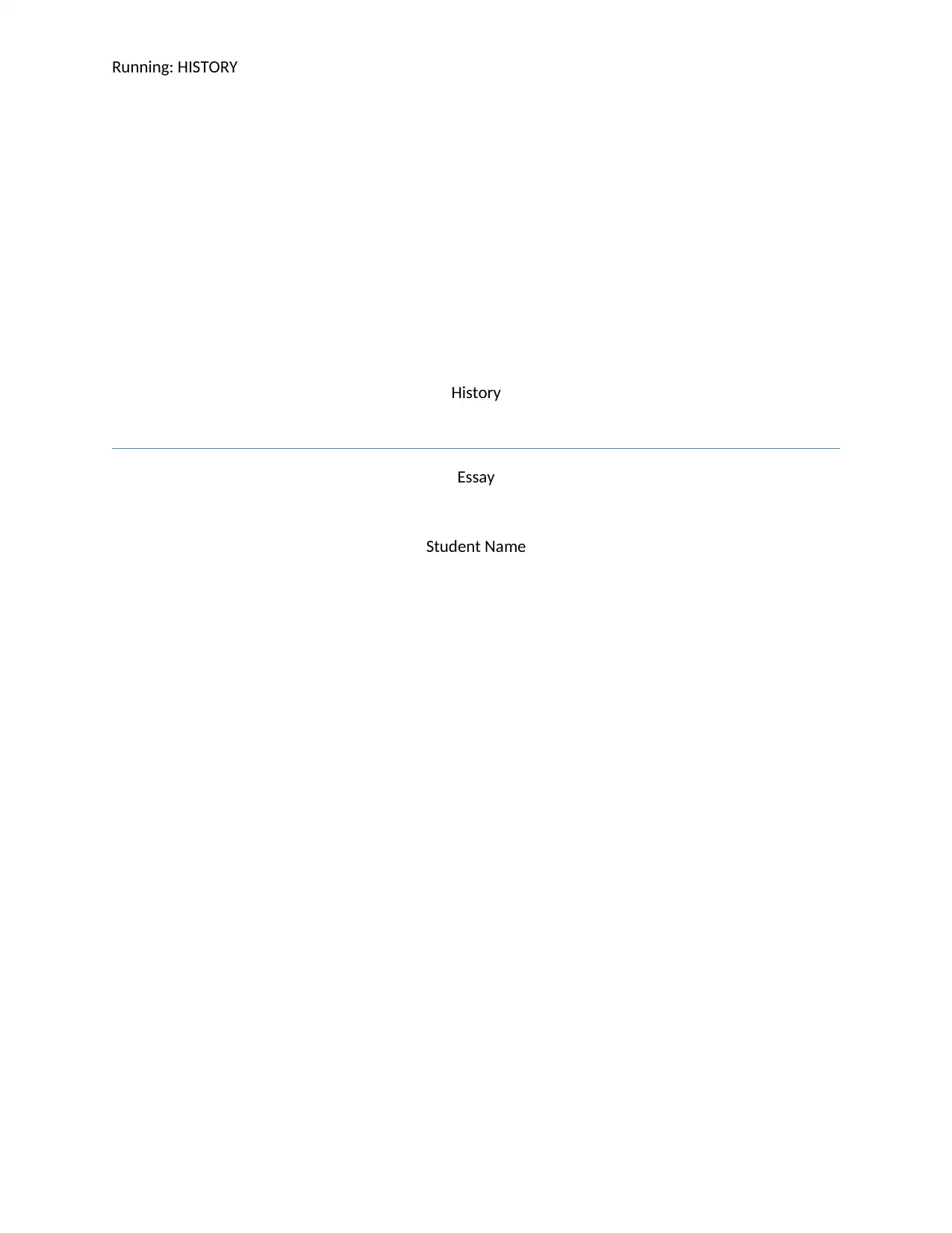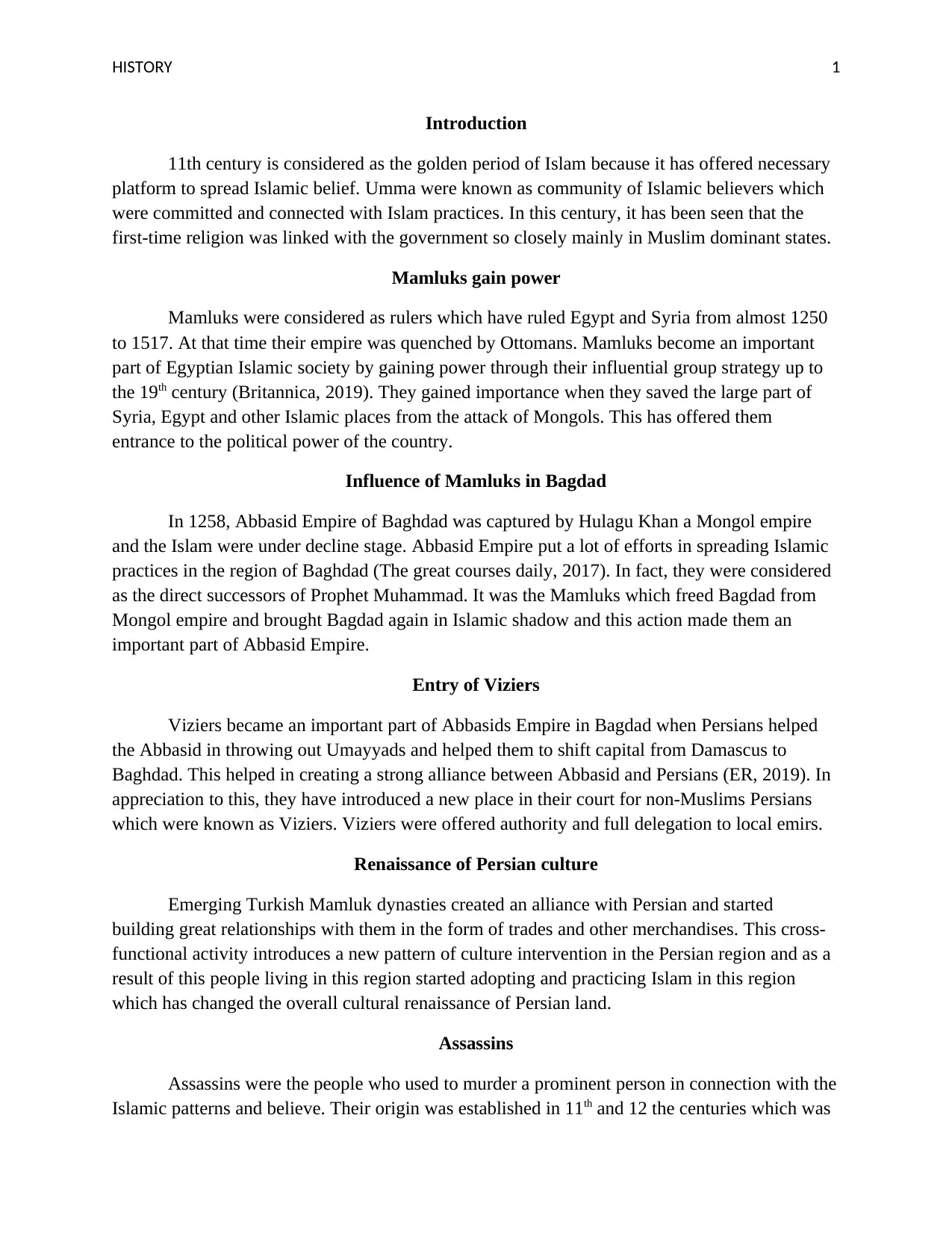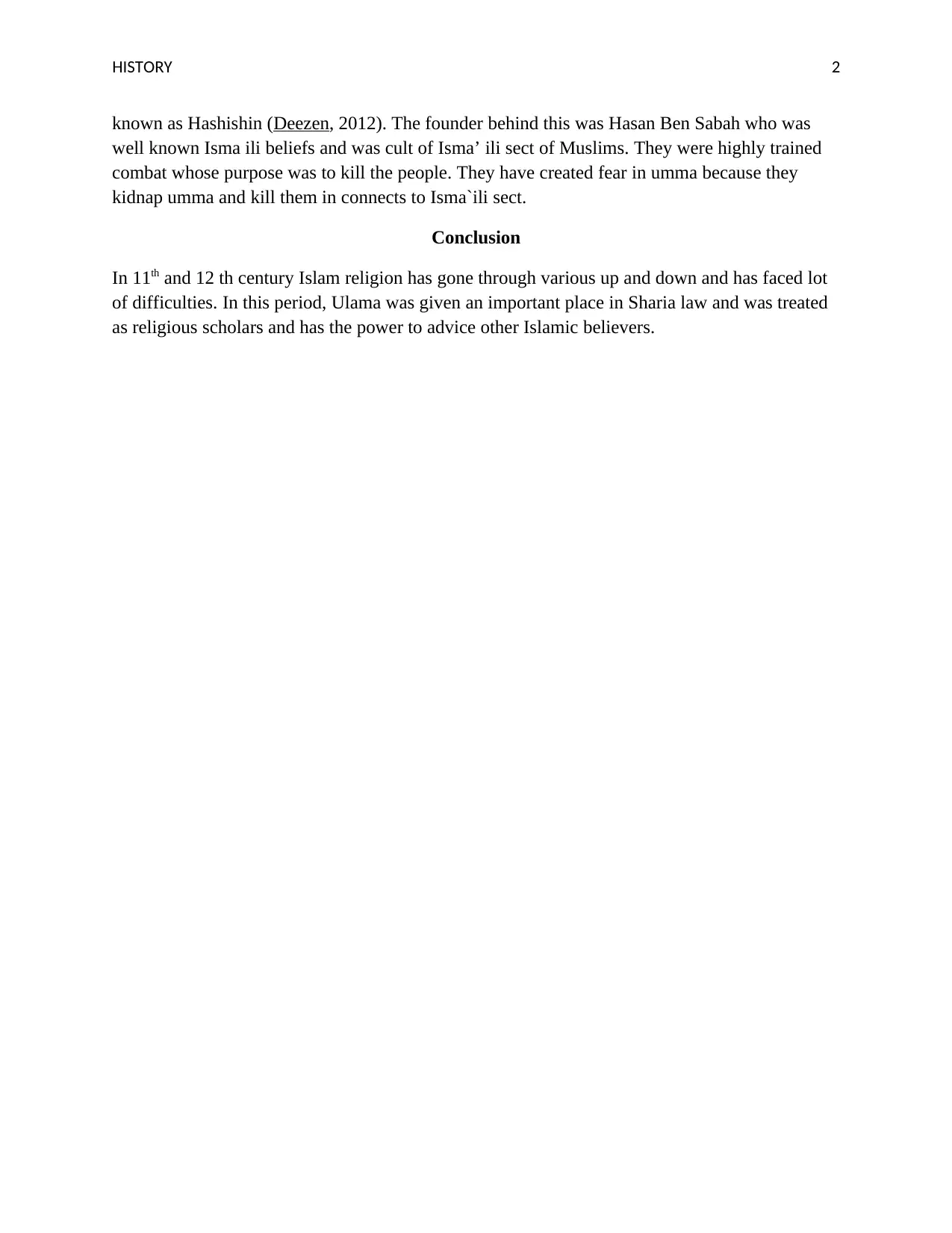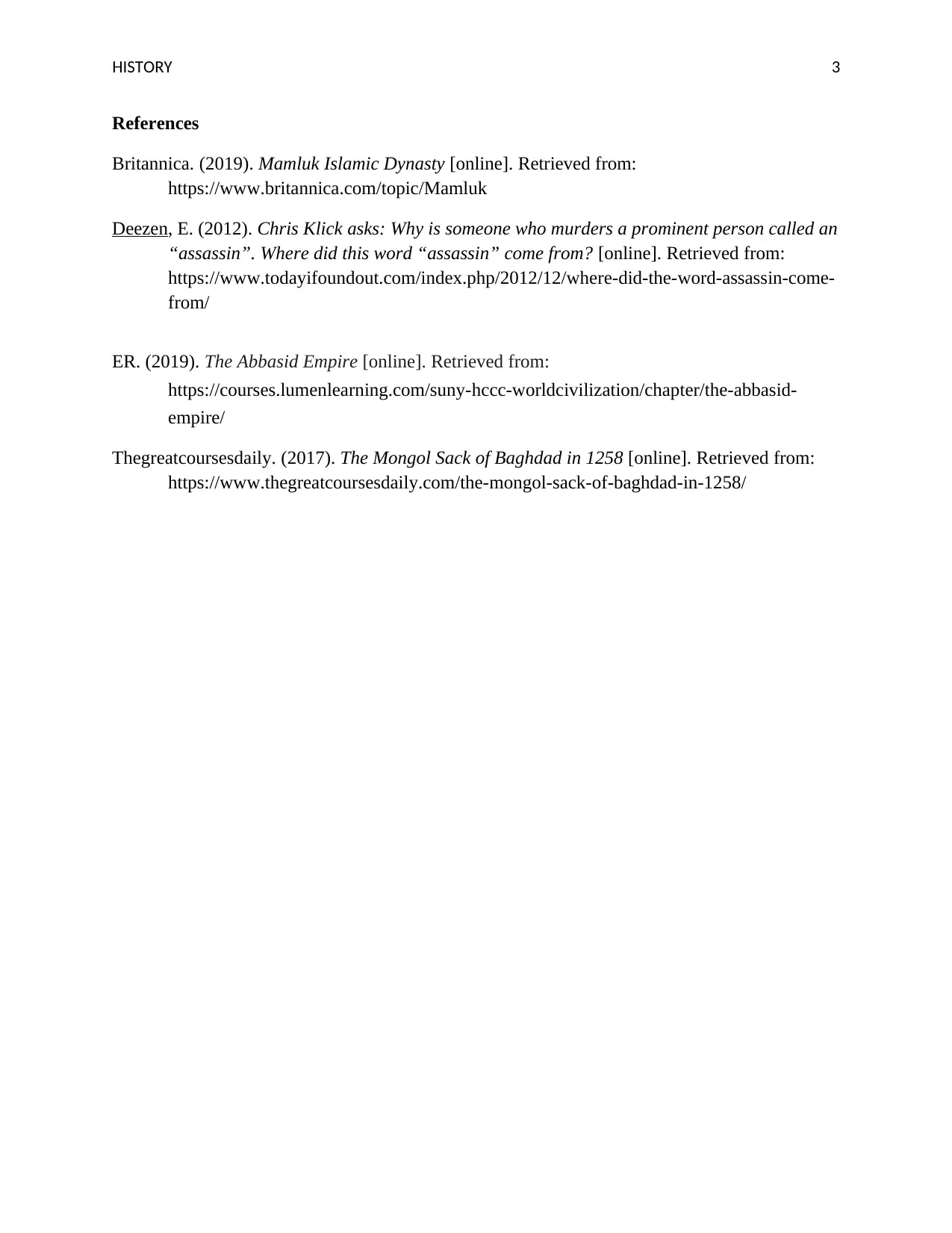History of Islam in the 11th and 12th Century
VerifiedAdded on 2022/12/29
|4
|681
|89
AI Summary
This essay explores the history of Islam in the 11th and 12th century, focusing on the rise of Mamluks, their influence in Baghdad, the role of Viziers, the renaissance of Persian culture, and the presence of Assassins. It also discusses the importance of Ulama in Sharia law during this period.
Contribute Materials
Your contribution can guide someone’s learning journey. Share your
documents today.

Running: HISTORY
History
Essay
Student Name
History
Essay
Student Name
Secure Best Marks with AI Grader
Need help grading? Try our AI Grader for instant feedback on your assignments.

HISTORY 1
Introduction
11th century is considered as the golden period of Islam because it has offered necessary
platform to spread Islamic belief. Umma were known as community of Islamic believers which
were committed and connected with Islam practices. In this century, it has been seen that the
first-time religion was linked with the government so closely mainly in Muslim dominant states.
Mamluks gain power
Mamluks were considered as rulers which have ruled Egypt and Syria from almost 1250
to 1517. At that time their empire was quenched by Ottomans. Mamluks become an important
part of Egyptian Islamic society by gaining power through their influential group strategy up to
the 19th century (Britannica, 2019). They gained importance when they saved the large part of
Syria, Egypt and other Islamic places from the attack of Mongols. This has offered them
entrance to the political power of the country.
Influence of Mamluks in Bagdad
In 1258, Abbasid Empire of Baghdad was captured by Hulagu Khan a Mongol empire
and the Islam were under decline stage. Abbasid Empire put a lot of efforts in spreading Islamic
practices in the region of Baghdad (The great courses daily, 2017). In fact, they were considered
as the direct successors of Prophet Muhammad. It was the Mamluks which freed Bagdad from
Mongol empire and brought Bagdad again in Islamic shadow and this action made them an
important part of Abbasid Empire.
Entry of Viziers
Viziers became an important part of Abbasids Empire in Bagdad when Persians helped
the Abbasid in throwing out Umayyads and helped them to shift capital from Damascus to
Baghdad. This helped in creating a strong alliance between Abbasid and Persians (ER, 2019). In
appreciation to this, they have introduced a new place in their court for non-Muslims Persians
which were known as Viziers. Viziers were offered authority and full delegation to local emirs.
Renaissance of Persian culture
Emerging Turkish Mamluk dynasties created an alliance with Persian and started
building great relationships with them in the form of trades and other merchandises. This cross-
functional activity introduces a new pattern of culture intervention in the Persian region and as a
result of this people living in this region started adopting and practicing Islam in this region
which has changed the overall cultural renaissance of Persian land.
Assassins
Assassins were the people who used to murder a prominent person in connection with the
Islamic patterns and believe. Their origin was established in 11th and 12 the centuries which was
Introduction
11th century is considered as the golden period of Islam because it has offered necessary
platform to spread Islamic belief. Umma were known as community of Islamic believers which
were committed and connected with Islam practices. In this century, it has been seen that the
first-time religion was linked with the government so closely mainly in Muslim dominant states.
Mamluks gain power
Mamluks were considered as rulers which have ruled Egypt and Syria from almost 1250
to 1517. At that time their empire was quenched by Ottomans. Mamluks become an important
part of Egyptian Islamic society by gaining power through their influential group strategy up to
the 19th century (Britannica, 2019). They gained importance when they saved the large part of
Syria, Egypt and other Islamic places from the attack of Mongols. This has offered them
entrance to the political power of the country.
Influence of Mamluks in Bagdad
In 1258, Abbasid Empire of Baghdad was captured by Hulagu Khan a Mongol empire
and the Islam were under decline stage. Abbasid Empire put a lot of efforts in spreading Islamic
practices in the region of Baghdad (The great courses daily, 2017). In fact, they were considered
as the direct successors of Prophet Muhammad. It was the Mamluks which freed Bagdad from
Mongol empire and brought Bagdad again in Islamic shadow and this action made them an
important part of Abbasid Empire.
Entry of Viziers
Viziers became an important part of Abbasids Empire in Bagdad when Persians helped
the Abbasid in throwing out Umayyads and helped them to shift capital from Damascus to
Baghdad. This helped in creating a strong alliance between Abbasid and Persians (ER, 2019). In
appreciation to this, they have introduced a new place in their court for non-Muslims Persians
which were known as Viziers. Viziers were offered authority and full delegation to local emirs.
Renaissance of Persian culture
Emerging Turkish Mamluk dynasties created an alliance with Persian and started
building great relationships with them in the form of trades and other merchandises. This cross-
functional activity introduces a new pattern of culture intervention in the Persian region and as a
result of this people living in this region started adopting and practicing Islam in this region
which has changed the overall cultural renaissance of Persian land.
Assassins
Assassins were the people who used to murder a prominent person in connection with the
Islamic patterns and believe. Their origin was established in 11th and 12 the centuries which was

HISTORY 2
known as Hashishin (Deezen, 2012). The founder behind this was Hasan Ben Sabah who was
well known Isma ili beliefs and was cult of Isma’ ili sect of Muslims. They were highly trained
combat whose purpose was to kill the people. They have created fear in umma because they
kidnap umma and kill them in connects to Isma`ili sect.
Conclusion
In 11th and 12 th century Islam religion has gone through various up and down and has faced lot
of difficulties. In this period, Ulama was given an important place in Sharia law and was treated
as religious scholars and has the power to advice other Islamic believers.
known as Hashishin (Deezen, 2012). The founder behind this was Hasan Ben Sabah who was
well known Isma ili beliefs and was cult of Isma’ ili sect of Muslims. They were highly trained
combat whose purpose was to kill the people. They have created fear in umma because they
kidnap umma and kill them in connects to Isma`ili sect.
Conclusion
In 11th and 12 th century Islam religion has gone through various up and down and has faced lot
of difficulties. In this period, Ulama was given an important place in Sharia law and was treated
as religious scholars and has the power to advice other Islamic believers.

HISTORY 3
References
Britannica. (2019). Mamluk Islamic Dynasty [online]. Retrieved from:
https://www.britannica.com/topic/Mamluk
Deezen, E. (2012). Chris Klick asks: Why is someone who murders a prominent person called an
“assassin”. Where did this word “assassin” come from? [online]. Retrieved from:
https://www.todayifoundout.com/index.php/2012/12/where-did-the-word-assassin-come-
from/
ER. (2019). The Abbasid Empire [online]. Retrieved from:
https://courses.lumenlearning.com/suny-hccc-worldcivilization/chapter/the-abbasid-
empire/
Thegreatcoursesdaily. (2017). The Mongol Sack of Baghdad in 1258 [online]. Retrieved from:
https://www.thegreatcoursesdaily.com/the-mongol-sack-of-baghdad-in-1258/
References
Britannica. (2019). Mamluk Islamic Dynasty [online]. Retrieved from:
https://www.britannica.com/topic/Mamluk
Deezen, E. (2012). Chris Klick asks: Why is someone who murders a prominent person called an
“assassin”. Where did this word “assassin” come from? [online]. Retrieved from:
https://www.todayifoundout.com/index.php/2012/12/where-did-the-word-assassin-come-
from/
ER. (2019). The Abbasid Empire [online]. Retrieved from:
https://courses.lumenlearning.com/suny-hccc-worldcivilization/chapter/the-abbasid-
empire/
Thegreatcoursesdaily. (2017). The Mongol Sack of Baghdad in 1258 [online]. Retrieved from:
https://www.thegreatcoursesdaily.com/the-mongol-sack-of-baghdad-in-1258/
1 out of 4
Your All-in-One AI-Powered Toolkit for Academic Success.
+13062052269
info@desklib.com
Available 24*7 on WhatsApp / Email
![[object Object]](/_next/static/media/star-bottom.7253800d.svg)
Unlock your academic potential
© 2024 | Zucol Services PVT LTD | All rights reserved.
